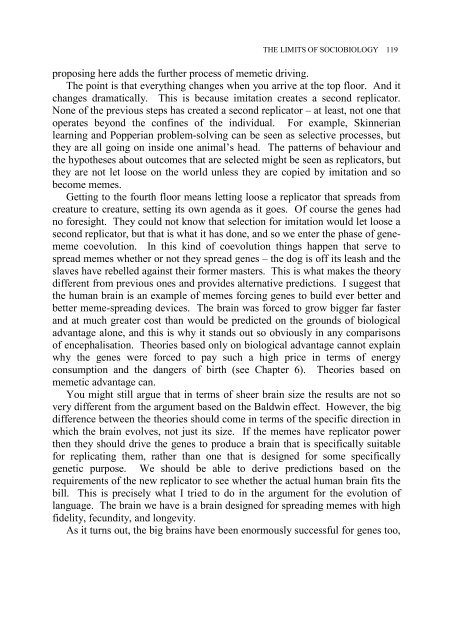The Meme Machine
TheMemeMachine1999
TheMemeMachine1999
- No tags were found...
Create successful ePaper yourself
Turn your PDF publications into a flip-book with our unique Google optimized e-Paper software.
THE LIMITS OF SOCIOBIOLOGY 119<br />
proposing here adds the further process of memetic driving.<br />
<strong>The</strong> point is that everything changes when you arrive at the top floor. And it<br />
changes dramatically. This is because imitation creates a second replicator.<br />
None of the previous steps has created a second replicator – at least, not one that<br />
operates beyond the confines of the individual. For example, Skinnerian<br />
learning and Popperian problem-solving can be seen as selective processes, but<br />
they are all going on inside one animal’s head. <strong>The</strong> patterns of behaviour and<br />
the hypotheses about outcomes that are selected might be seen as replicators, but<br />
they are not let loose on the world unless they are copied by imitation and so<br />
become memes.<br />
Getting to the fourth floor means letting loose a replicator that spreads from<br />
creature to creature, setting its own agenda as it goes. Of course the genes had<br />
no foresight. <strong>The</strong>y could not know that selection for imitation would let loose a<br />
second replicator, but that is what it has done, and so we enter the phase of genememe<br />
coevolution. In this kind of coevolution things happen that serve to<br />
spread memes whether or not they spread genes – the dog is off its leash and the<br />
slaves have rebelled against their former masters. This is what makes the theory<br />
different from previous ones and provides alternative predictions. I suggest that<br />
the human brain is an example of memes forcing genes to build ever better and<br />
better meme-spreading devices. <strong>The</strong> brain was forced to grow bigger far faster<br />
and at much greater cost than would be predicted on the grounds of biological<br />
advantage alone, and this is why it stands out so obviously in any comparisons<br />
of encephalisation. <strong>The</strong>ories based only on biological advantage cannot explain<br />
why the genes were forced to pay such a high price in terms of energy<br />
consumption and the dangers of birth (see Chapter 6). <strong>The</strong>ories based on<br />
memetic advantage can.<br />
You might still argue that in terms of sheer brain size the results are not so<br />
very different from the argument based on the Baldwin effect. However, the big<br />
difference between the theories should come in terms of the specific direction in<br />
which the brain evolves, not just its size. If the memes have replicator power<br />
then they should drive the genes to produce a brain that is specifically suitable<br />
for replicating them, rather than one that is designed for some specifically<br />
genetic purpose. We should be able to derive predictions based on the<br />
requirements of the new replicator to see whether the actual human brain fits the<br />
bill. This is precisely what I tried to do in the argument for the evolution of<br />
language. <strong>The</strong> brain we have is a brain designed for spreading memes with high<br />
fidelity, fecundity, and longevity.<br />
As it turns out, the big brains have been enormously successful for genes too,



